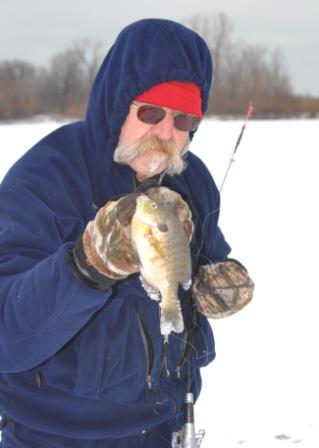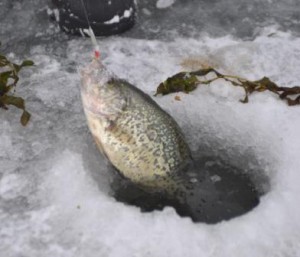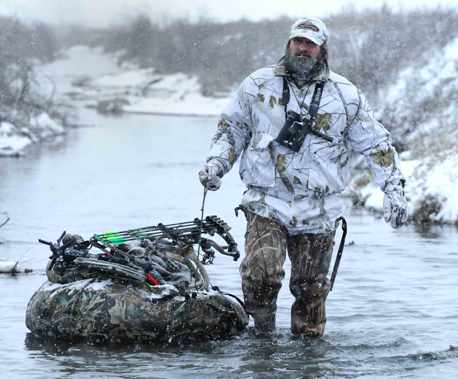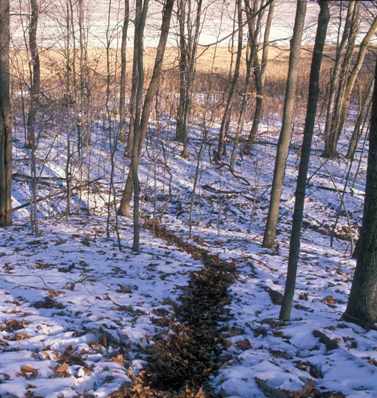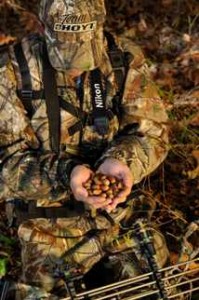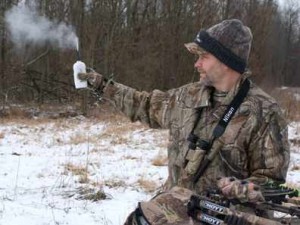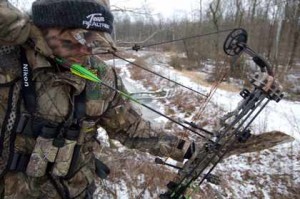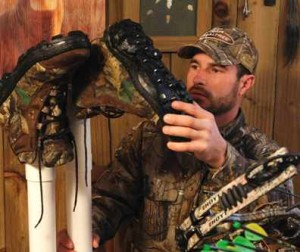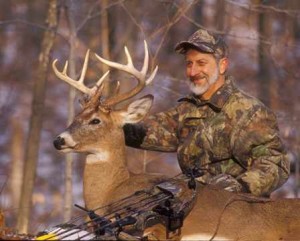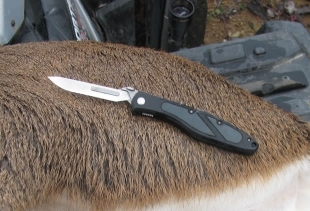Ice Fishing Tips for Lake Erie
“Lake Erie perch!”
“Bluegill through the ice!”
“I say Lake Erie perch!”
“Yea, they’re good, but you just can’t beat bluegill through the ice.”
Two of my fishing buddies walked onto the ice before me. They had gotten there early enough to have plenty of holes drilled, and to get into one of these ridiculous fishermen arguments, this time over what is the best tasting freshwater fish. It was all the more ridiculous because we were fishing in a bay off Lake Erie where we were likely to catch both perch and bluegill. Quite often our catches there also include crappie and pumpkinseed. So maybe it is not one of the great mysteries of life. It is a great argument nonetheless because no matter which side prevails every side comes out a winner.
These comparatively small fish are collectively called ‘panfish’ for very good reason. They are the right size for a frying pan, and they come out of the frying pan tasting great. Taste is enhanced by the way they are handled while ice-fishing. Anglers typically toss fish onto the ice as soon as they are unhooked where they quickly freeze, then at the end of the day they are collected in a plastic bucket for transportation. Some ice-fishermen try to get sneaky by putting their fish into a plastic bucket immediately so no one else can see their catches.
Panfish Rate Second Only to Bass in Popularity
Anglers love panfish, and a large share are enthusiastic about ice-fishing for these tasty critters. According to the 2006 National Survey of Fishing, Hunting, and Wildlife-Associated Recreation, a U.S. Fish and Wildlife Service report which is done every five years, panfish rate second only to bass in popularity among anglers, and in that part of the survey crappie are not included as panfish. If crappie are thrown in with the panfish group, as they are classified by most anglers, then the panfish group is far more popular than any other type of fish. Ice-fishing is not compared with open water fishing in popularity, however you get a pretty good notion about the popularity of ice-fishing when you consider that ice-fishermen annually spend more than $81-million on equipment.
Great eating is just one of the main reasons that ice-fishing for panfish is so popular. Panfish generally are abundant, and in the better panfish lakes there is a good chance that at least one species is cooperating. At the Great Lakes bay nearest my home, crappie tend to hit best through early ice and late ice. Perch often go on a feeding binge during February. Bluegill and pumpkinseed are most cooperative of all, hitting well all through winter. Of course, none of this is a guarantee that any fish will be hitting at any particular moment. Just like other fish, there will be fast times and slow times, but mostly fair times.
Panfish limits are typically quite generous. Limit catches are more common than they are with most other species. My own personal limits which are fewer than the regulations allow are based on how many fish I want to fillet, or how many I can eat. I see no sense in stocking my freezer with so many fish fillets that some get freezer burnt. Tactics used to ice-fish for panfish may vary somewhat between the specific panfish that are targeted, but since more than one panfish species are often present at the more popular ice-fishing lakes, tactics that appeal to all panfish are very useful.
My Personal Favorite is a Two Jig Rig
Perhaps the most widely useful terminal rig used to ice-fish for panfish, and my personal favorite terminal rig, is a two jig rig. The upper jig is usually a teardrop jig, or something similar, and the lower jig, the terminal jig, is a jigging spoon. The reason for having the jigging spoon at the bottom is because it is heavier so it sinks fastest.
A simple concept, having the heavier jig at the end of the line serves one of the most basic, most important tasks, locating bottom. With a relatively heavy jig an ice-fisherman can feel bottom. That is, an angler can feel the difference in tension on the line when the jigging spoon hits bottom. Even if this cannot be felt, you can still detect bottom by watching the line. A jigging spoon keeps tension on the line. When the jigging spoon hits bottom there is no longer tension on the line so it begins to coil into loops, or a spiral shape.
Tying the Two Jig Terminal Rig
This does not mean that panfish are always close to bottom, it is just a starting point. Of course tying the two jig terminal rig is simple, but it may not be easy because the line, either 3 pound-test monofilament ice line or 4 pound-test fluorocarbon are my preferences, is so thin that seeing it is difficult. I have a good reason for tying the rig exactly the way I do it. First the teardrop jig is tied to the end of the line. Next cut the line above the jig so the cut piece of line is a few inches longer than the distance of separation you want between the jigs. This extra line is used up tying knots. Next tie the jig to the end of the main line again, tying it to the line eye just where the first knot was tied. Then the jigging spoon is tied to the terminal end of the leader. Now you are ready to tip the jigs with bait.
Why tie both knots to the eye of the upper jig rather than tying that jig on a dropper line? Dropper lines are constantly tangling. Only rarely will the line tangle with the upper jig tied right into the running, or main, line. As far as I have been able to determine, tying the rig this way does not reduce hits a bit. It may even increase hits on the upper jig.
Use Different Colors on the Upper and Lower Jigs
Use different colors on the upper and lower jigs, and tip them with different baits unless a pattern has already been established. There are so many ‘favorite’ jig color patterns that suggesting specific color patterns amounts to a list of every combination imaginable. Instead, just ask the local tackle shop for suggestions, or ask ice-fishermen who are familiar with the lake.
Baits used to tip the small jigs that are used for panfish typically are either minnows or grubs. Keep the entire rig small since the mouths of some panfish are very small. Among the more popular panfish in ice-fishing territory, the various sunfish, notably bluegill, have the smallest mouths. Maggots are usually my bait of choice for sunfish. If you have the chance, watch sunfish hitting a jig tipped with bait. You will see that they nip at the bait. Small sunfish will not even get the hook into their mouths. Crappie and yellow perch have comparatively large mouths. Small minnows, especially shiners where they are available, may be the best bait for both of these species. Larger grubs such as wax worms or meal worms may be more effective at times. Black crappie tend to favor grubs over minnows, while white crappie, especially if you are specifically targeting large fish, prefer minnows in most cases.
Ice-fishing has some obvious limitations. One of these is that lifting and dropping a lure is about all that can be done to give it action. The shape of the jig can add something to the action, but still the angler is limited to lifting and dropping. The variables are the length and the speed of the lift, and the speed of the drop. Before accepting this limitation though, use your imagination. You can do more than first meets the eye. This is strictly for hard-core ice-fishermen. Casual ice-fishermen rarely will put this much effort onto their fishing, and they seldom will believe that doing these little things can be so important.
Using a Longer Jigging Rod Increases Your Chances
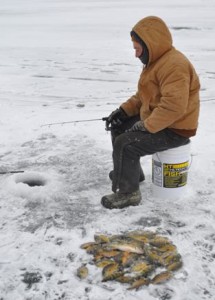
Tossing fish on the ice as soon as they are unhooked freezes them quickly. This preserves their flavor.
Using a longer jigging rod increases the variables that can be employed with ice jigs because it increases the distance the jig can be lifted. This in turn allows more things that can be applied to the lift. A simple lift can be changed to a series of short lifts which raise the jigs as much as 6 feet while you are sitting on a bucket. An action of this sort tends to be very effective for crappie for a couple of reasons. Sometimes crappie seem to want a jig to be rising or dropping. Crappie may be anywhere in the water column, and they might change their depth in a second. Commonly, crappie move upward when they get most active.
Bluegill and other sunfish usually prefer that a jig barely moves, except for an occasional lift to get their attention. It is the aroma of the bait that makes then strike, whereas the jigging motion may be the primary thing that attracts strikes by perch and crappie. Setting the hook quickly is usually imperative to catching a good mess of bluegill. These fish tend to suck the hook into their mouth and expel it very quickly. Keep a close watch on the rod tip.
A Rod With a Very Sensitive Tip is One Which Bends
This brings us to one of the most important tackle choices necessary to catch panfish through the ice. Feeling a panfish take a jig is just about impossible when you are wearing gloves, or when your hands are cold. Sensitivity means seeing the rod tip bend. A rod with a very sensitive tip is one which bends under the least amount of pull. You can add to this sensitivity by painting the rod tip fluorescent red or some other highly visible color.
The ice-fisherman who consistently has panfish flopping on the ice is one who pays attention to all details, things that other ice-fishermen ignore.
CRISPY BLUEGILL CHIPS
There are lakes where big bluegill are abundant. But there are many more where any sunfish longer than 6 inches is unusual. You can still get great tasting fillets when the panfish are small if you fillet them using an ultra-sharp knife like the Havalon Baracuta Fillet Knife. Only with this extremely sharp blade can you get worthwhile fillets from modest-size panfish.
When you are ready to eat, prepare a mixture of corn starch and onion salt. Remove the fillets from the water solution, rinse them well, then shake them in a plastic bag with the corn starch and onion powder. Fry in hot oil, and you have a great meal of thin panfish fillets.
3,939 total views, no views today


